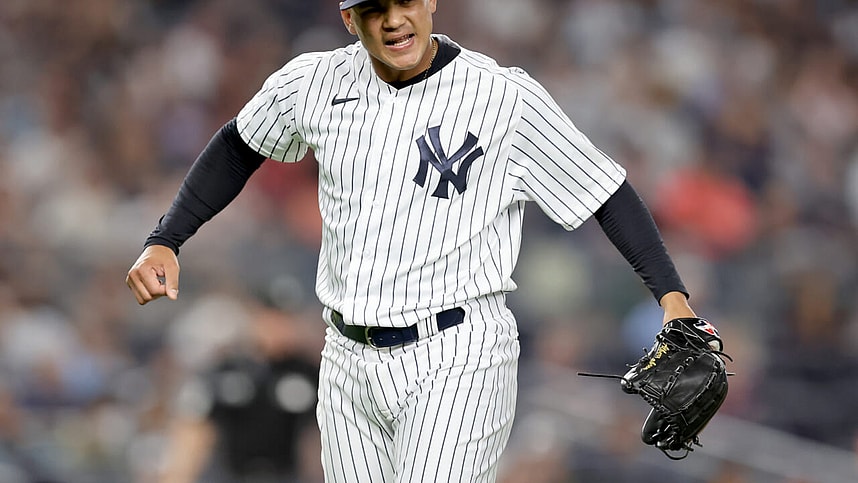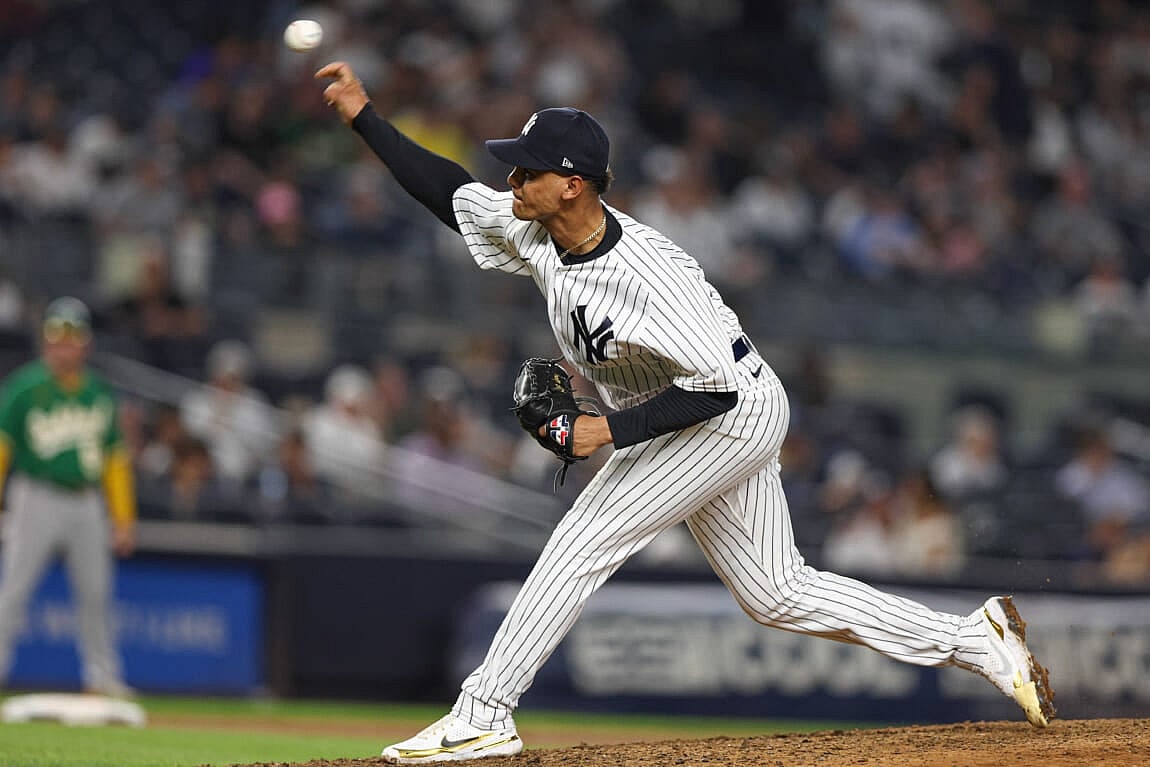
Arguably the best pitching staff in baseball, the Yankees are loaded with talent from top to bottom. While the high-leverage arms in the bullpen and the star-studded rotation are what get the most coverage (and rightfully so), the Yankees have a reliever in the backend of their bullpen that could take a huge leap in 2023. The Yankees are at the forefront of pitching development, taking what pitchers do extremely well and optimizing it in a manner that allows them to have success at the highest level of professional baseball. Albert Abreu had a turbulent 2022, but he showed that he has some of the best raw stuff in the game.
- The Yankees might have found their next Luke Weaver in $2 million signing
- Yankees predicted to land Bo Bichette but the reason is ludicrous
- Yankees re-sign Paul Blackburn to one-year $2 million contract
How the Yankees Unlocked Albert Abreu
Albert Abreu simplified his pitch mix into a two-pitch mix mostly, using a sinker and slider combination with the occasional changeup while with the Yankees. He relied heavily on his sinker, using it 58.4% of the time while with the Yankees, which is way up from his 31.7% usage with the Rangers and Royals earlier that season. It’s no surprise that he went to the pitch so much, as it’s the one he has the best command of. With a blistering 98.5 MPH of white-hot velocity, his sinker held batters to a .298 wOBA and -4° launch angle, and with the Yankees, he saw a massive drop in his walk rate.
Abreu has always had a command problem that limited him to being a depth reliever, but with the Yankees, he walked just 5.6% of the batters he faced. His career BB% up to that point was a whopping 16.0% which is not just bad, it rendered him unserviceable at the big league level. There’s a reason he was DFA’d twice before ending up with the Yankees, though it’s also not fair to expect him to have command of four separate pitches. His sinker became a pitch he could rely upon in any spot, and the profile of the pitch justifies that decision.
The second pitch he utilized a lot in his adjustment with the Yankees was his slider, which profiles more like a hard cutter but is absolutely gross due to its velocity. It boasted a 112.6 Stuff+, which is the best mark on any pitch in his arsenal. His slider doesn’t generate much sweep or drop, but it generates enough movement down and in at nearly 90 MPH to get batters to swing and miss at it frequently. It held batters to a .185 wOBA and 45.1% Whiff%, being his primary strikeout option. You might think that this would make Abreu ineffective against opposite-handed hitters, but he handled lefties just fine.
Left-handed batters registered a .283 wOBA and 31.4% K% against Abreu after he was picked up by the Yankees, and that’s because his sinker could run off of the plate fast enough to generate weak contact, a whiff, or just called strike on the borders of the strike zone. He’s incorporated the occasional changeup against lefties when needed, and it was effective in those matchups, with lefties striking out over 60% of the time against the pitch, though they did register a .369 wOBA against the pitch, which is sub-optimal. We’ll discuss what happened in those matchups later on.
The pitch Abreu effectively removed from his pitch mix was his four-seam fastball, which was his primary (and only) fastball when he debuted in 2020. He used the pitch 16.4% of the year in 2021, but with the Yankees last season, he used it just 23 times. The pitch grades well in Stuff+ (115.7) but never got the results he was looking for, consistently getting crushed in his carer (.439 wOBA). Becoming a sinker-centric arm with a great slider and the occasional changeup just made things a lot easier for the 27-year-old righty, and that’s the goal of pitching development.
We saw Albert Abreu post a FIP under 3 with the Yankees, but he broke down towards the end and quickly fell out of favor with the fanbase. What went wrong for Abreu in the final month of the season, and should we be concerned about his future outlook?
What Went Wrong in August?
Albert Abreu’s sinker became highly ineffective down the stretch, and that was due to it losing some of its vertical drop over the final month of the season. Let’s take a look at a series the Yankees had against the Blue Jays late in August that featured Albert Abreu twice before he hit the IL.
This is a sinker that gets hammered at 110.7 MPH for a single, and Springer would be one of 3 runs that would score against Abreu, 2 of them being earned. This sinker registered just 12″ of drop, which isn’t going to sink enough to get Springer to swing over the pitch for a groundball or a strikeout, instead running right into his swing plane for damage.
The changeup from earlier that generated a ton of strikeouts but had a poor wOBA against? Well, at-bats like this are precisely why. This changeup dropped just 23 inches, over 3 inches less than his changeup normally drops, thus, he hung it right in the wheelhouse of a 129 wRC+ hitter in Teoscar Hernandez. These types of at-bats became the norm for Abreu in August, who had a 3.19 SIERA but got the breaks beaten off of him whenever he gave up contact.
Batters generated an 11.1% Barrel%, 91.4 Average EV, and .384 wOBA in the month of August. This gave Abreu an ugly 7.88 ERA in the month, and the most alarming metrics were the changes in batted ball distribution, as we saw Abreu go from a groundball machine who avoided line drives like the plague to a pitcher who rarely generated contact on the ground.
- Line Drive Rate: 18.7% -> 29.6%
- Groundball Rate: 55.6% -> 37.0%
- Barrel Rate: 0.0% -> 11.1%
Having a sinker that actually sinks is paramount to success, and it would be revealed after an August 20th outing against Toronto that the Yankees would place Abreu on the IL with right elbow inflammation. This provides the context needed for his sudden struggles with his dominant sinker, and we wouldn’t see Abreu until October, when he’d throw an inning and not see any postseason action after. No one wants to hear “excuses” for poor performance, but the situation at the time was that the Yankees had been struggling in the bullpen, so it could have been possible that Abreu attempted to pitch through injury in order to keep the bullpen depth steady.

It’s not unreasonable to say that the sample between June and July, where Abreu was a groundball machine that could generate whiffs and chases as well reflects who he was more than that injured shell of himself. In August, we saw Abreu average the worst vertical break on his sinker (14″) out of any month of the season, and it’s no coincidence that it was that month that he struggled. It’s not unreasonable to assume that had he been healthy, he could have had a more productive month and left a better impression on Yankee fans. His August was disastrous, and in the context of the 2022 season, you couldn’t trust Abreu to pitch in a postseason environment.
2023 is a new slate, and the Yankees are going to have a bullpen spot open for Abreu to compete for, with Michael King not slated to return for Opening Day and an 8th bullpen spot that will be up for grabs all season. The Yankees have developed plenty of arms in the last couple of years, and Abreu can join the list of bullpen success stories. We saw a fragment of what he could be last season, as his final totals with the Yankees on the season were still impressive.
With a 3.16 ERA, 2.92 FIP, and 3.01 SIERA, we saw that Albert Abreu can put up strong numbers even if he struggles during the season. His blistering sinker will make him a groundball threat with an infield that was remarkable defensively last season and has a new SS in Peraza that can elevate the defensive play there. As he keeps working on his changeup, he’ll continue to blossom into higher-leverage roles throughout the season and become the reliever the Yankees envisioned he could be when they acquired him for Brian McCann after the 2016 season.
Everything is there for Albert Abreu to break out next season, especially if his sinker is the sinker we saw early in the summer last year. He could be a 55% GB% pitcher with a ~18% K-BB%, which would make him not just a good reliever for the Yankees, but one of the best relievers in all of baseball. It seems like a longshot, but Albert Abreu is going to become one of the more reliable arms in this bullpen, and the Yankees will be more than glad they didn’t just trade him for roster space.
More about: New York Yankees